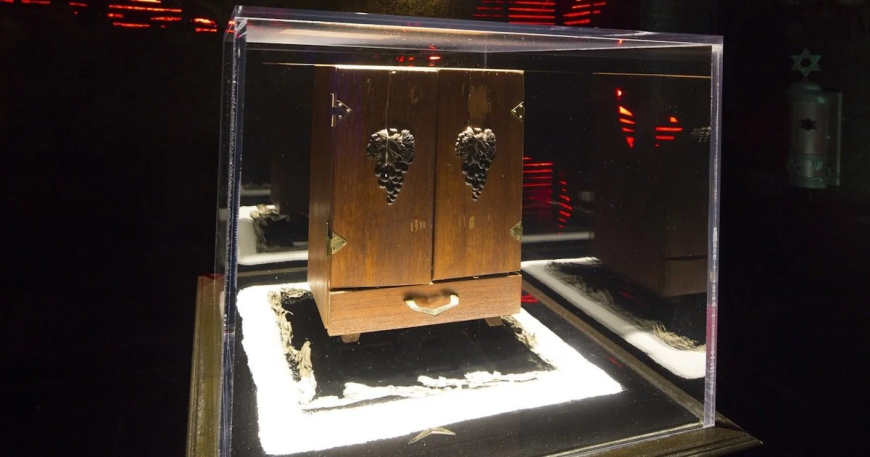The Dybbuk Box: A Cursed Relic or an Elaborate Hoax?
Explore the legend of the Dybbuk Box—one of the most famous haunted objects in history. Is it truly cursed, or is it all just a hoax?

For years, tales of the Dybbuk Box have fascinated paranormal enthusiasts and skeptics alike. Some claim this mysterious wooden wine cabinet houses a malicious spirit, bringing misfortune to its owners. Others dismiss it as a carefully crafted hoax designed to captivate the masses. But what is the real story behind the Dybbuk Box? Is it truly haunted, or is it just another piece of paranormal folklore that has been blown out of proportion?
The Origins: A Tale of the Supernatural
The legend of the Dybbuk Box dates back to 2003, when Kevin Mannis, a writer and antique collector, purchased the strange wooden cabinet at an estate sale in Oregon. Mannis claimed that the box had once belonged to a Holocaust survivor, who warned him never to open it. Ignoring the warning, Mannis and subsequent owners experienced eerie and terrifying occurrences, including:
-
Unexplained nightmares
-
Shadowy figures lurking in the darkness
-
Sudden illnesses and mysterious pains
-
The smell of jasmine and cat urine appearing out of nowhere
Mannis eventually sold the box on eBay, and it quickly gained notoriety as an alleged haunted artifact. The listing caught the attention of paranormal investigator Jason Haxton, who later wrote a book detailing his own experiences with the cursed object.
What is a Dybbuk?
The term "Dybbuk" originates from Jewish folklore. A Dybbuk is believed to be a malevolent spirit that clings to the soul of a living person, causing misfortune and suffering. According to Jewish mystical traditions, a Dybbuk is the soul of a deceased person unable to find peace, often seeking to possess the living. This belief aligns with the claims made about the Dybbuk Box—suggesting that the entity trapped inside is a restless spirit.
The Rise to Fame: From eBay to Hollywood
After its eBay listing went viral, the Dybbuk Box's reputation soared. News outlets covered the story, and it even caught the attention of Hollywood. In 2012, the horror film The Possession, produced by Sam Raimi, was directly inspired by the alleged real-life horrors of the Dybbuk Box.
With its rise to fame, the box changed hands multiple times, with various owners claiming to experience paranormal activity. Among them was Zak Bagans, host of Ghost Adventures, who acquired the artifact and featured it in his Haunted Museum in Las Vegas.
Bagans' encounter with the box was documented in his 2018 documentary Demon House, where he claimed to have suffered severe paranormal consequences after interacting with it. His museum now showcases the Dybbuk Box as one of its most terrifying attractions.
Skeptics and the Hoax Theory
Despite its eerie reputation, many skeptics argue that the Dybbuk Box is nothing more than an elaborate hoax. In 2021, Kevin Mannis himself admitted in an interview with Skeptoid that he fabricated the entire story as part of a creative writing project. His confession shook the paranormal community, leading many to question whether the box truly possessed any supernatural qualities.
Further analysis by paranormal debunkers suggests that the box's "cursed" effects could be attributed to psychological suggestion. When someone believes they are cursed, they may subconsciously manifest stress-induced symptoms like nightmares, paranoia, and even physical ailments— a phenomenon known as the nocebo effect.
Even Haxton, a former owner of the box, later admitted that while he experienced strange occurrences, he was not entirely convinced it was supernatural.
Scientific Explanations: Can Objects Really Be Haunted?
The Dybbuk Box legend raises a critical question: Can objects be haunted? While many cultures believe in haunted relics, there is little scientific evidence supporting the notion that spirits can attach themselves to inanimate objects.
Paranormal researchers suggest that hauntings often stem from psychological factors, environmental influences, and even confirmation bias—where people only notice things that support their pre-existing beliefs.
However, some experts in parapsychology argue that energy can be imprinted onto objects, a theory known as the Stone Tape Theory. This theory suggests that traumatic events can leave residual energy that certain people can sense, which could explain why some individuals feel uneasy around specific objects.
The Dybbuk Box Today: An Ongoing Mystery
Despite the confession of its original creator, the Dybbuk Box remains one of the most famous haunted artifacts in modern history. Visitors to Zak Bagans’ Haunted Museum still claim to experience unexplainable chills, dizziness, and fear when near the box.
Even if the box itself isn’t haunted, the psychological power of belief cannot be ignored. The story of the Dybbuk Box has taken on a life of its own, becoming a modern legend that continues to intrigue ghost hunters, skeptics, and horror enthusiasts alike.
Final Verdict: Paranormal Relic or Pure Myth?
So, is the Dybbuk Box truly cursed, or is it just a well-crafted hoax? The evidence suggests that much of the story was embellished or entirely fabricated. However, the power of suggestion, fear, and belief continues to fuel its legend.
Whether you believe in ghosts or not, the Dybbuk Box serves as a powerful reminder of how stories can shape our perception of reality. After all, sometimes the scariest thing isn't a ghost—it's the power of a well-told tale.
Related Reads and References
For further research on haunted objects and the psychology behind them, check out:
These resources provide a balanced perspective, allowing you to decide for yourself whether the Dybbuk Box is a haunted relic or just another well-crafted hoax.
What's Your Reaction?
 Like
0
Like
0
 Dislike
0
Dislike
0
 Love
0
Love
0
 Funny
0
Funny
0
 Angry
0
Angry
0
 Sad
0
Sad
0
 Wow
0
Wow
0



















































